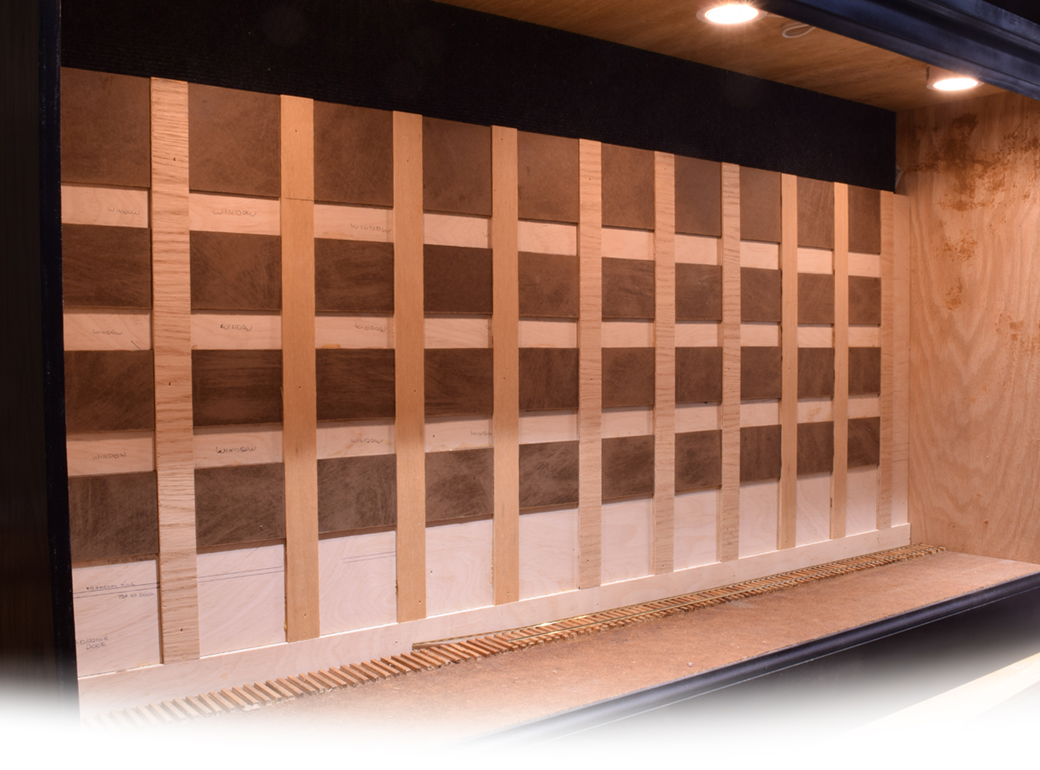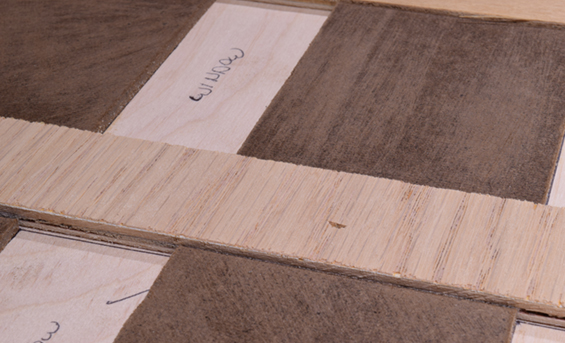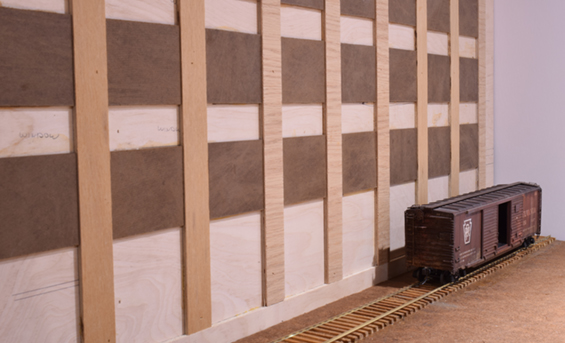
International Harvester Warehouse Flat (revised)
As you can see from the photo, I’ve built the sub-base for the warehouse.
The overall dimensions for the flat are four feet long by 21.75 inches high and including the stiffeners on the back, it’s less than two inches thick. It’s made from quarter-inch plywood and 1/8″ hardboard.
I laid out two bays with a combination square and a pen, taking the dimensions off the brick sheet, and used those measurements to cut the strips needed. The infill pieces were too small to safely cut on the tablesaw, so I used my miter saw with a stop block for those. Since the pieces are all consistent in width, I started on one end and glued each pilaster in place using the infill panels to space them. I marked a series of horizontal guidelines to keep the panel rows straight and even across the width of the flat.
At nearly eight square feet in area, this building has a real physical presence. It’s unlike anything I’ve built previously and I’m intrigued with the focused effect the display cabinet provides. (I temporarily fitted things in place to shoot the photo.) The following images give a close up of the details.

Basic dimensions were taken from the JTT brick sheet and marked off

Above the loading doors, the pilasters stand proud of the brick infill around the windows. 1/8″ hardboard allows for this inset.

I like how the size of the flat overwhelms the box car.
What this flat taught me is instructive.
We abide by certain maxims, whether we realize it or not. Call them whatever you want, rules, sacred cows, the name doesn’t matter. One of those maxims is that large scales don’t play nice with small spaces. In spite of the fact that it’s not true, we’ve heard this so often that we accept it as gospel and then seek whatever compromise we can live with.
In my view, we do this because our definition of a model railroad is so narrowly focused that we seldom consider any other possibility. Here in the US, if you can’t have distance running between multiple action centers, then you’re screwed. Almost without exception, any alternative is characterized as unsatisfying. Like so many other hobby oriented sacred cows we feed and nurture, this one dictates the questions asked and the resulting outcomes in more ways than you or I can imagine.
We are constantly told that regardless of the space we do have, it’s never enough. Is that true? No, it isn’t. I believe it to be a lie of the first order, one that creates a sense of inadequacy and want. Such thinking has trapped more people into endless rounds of starting layouts or struggling with silly design concepts, only to abandon the work for something else that makes the same empty promise.
This small display challenges my own assumptions. Seeing how the flat dwarfs a fifty-foot box car, I had to deal with the belief that it was too big. It isn’t. It’s to scale and represents the actual building well. What I needed to get over was the images of the small building kits that we’ve been conditioned by for decades.
I realized that in conventional layout practice, I expect to see a “factory” in the same context of the landscape, that I expect to see the railroad in. What this display is teaching me is that the building itself can provide that context. Here, the warehouse takes on the role of the landscape, while the cabinet focuses your attention by eliminating the distractions that would otherwise compete for it. Quarter-inch scale in this space reinforces that focus by virtue of how the building fills the available space. By altering the viewpoint and scale from what we expect to see, the scene makes a clearer statement: “You’re here, next to this building, looking at this freight car.” I don’t believe an HO scene would be as effective in this space, even though HO or N scales would be the default solution for “more.”
The more I study these aspects of design, the more intrigued I become and, I’m grateful for the recent writings of Chris Mears on this subject. He is a more original thinker than I am and we have often built on each other’s ideas. If there is one value we share, it’s that design plays a larger role than we give it credit for. Isolating the design of a layout, without considering how we will experience it, is part of what got us here. Getting out will require different thinking altogether.
Regards,
Mike
Well, the track gauge is to scale, the boxcar is to scale, so why not make the warehouse to scale, too?
Which is what you have done, and even without anything other than the wooden framework, the effect is astonishing.
Simon
Thank you Simon.
What I am drawn to is how strong and tangible the feeling of being immersed in the scene is, even in this basic form.
Mike
Maybe we should stop referring to “landscape”, and think of “setting”?
Simon
Yes. Excellent point.
Mike
Good morning,
Thanks for the compliment. I really appreciate it.
/chris
With regard to the scale and the space.
We to tend to perpetuate a rule that the ratio of scale to space is a function of how much track we can jam in. How much track itself is a natural function of the gauge, preferred curves, size of turnouts, etc. This measure should be more than just based on track and trains. It should be a function of how our story relates to the space. In the case of your project, I’m still looking at the original photo and peering down that alley. Who cares that we can’t see the rest of the town? I don’t. There’s just so much going on here and reveling in this myopia lets us increase the scale of each model to fill our space without selling out on the original point. I like the way the larger scale focusses our attention on the activities within the scene. Instead of a boxcar at the warehouse, it’s much easier to relate that it’s a boxcar at door three, at the warehouse.
We loose that sense of mass when we travel down in scale. We exchange it for distance. In the case of the urban scene like this, for it to really work, we need that mass, that sense of vertical scale, and how tightly elements share space with each other. Sure, in N, we can fit in a whole lot more of everything but we just can’t even begin to compete on communicating that sense of how tall things are. It’s hard to look up when the models are so small that it’s so difficult to not look over.
/chris
I’m sure there are other errors, but I’ve just noticed “I’ll still looking” which should have read “I’m still…”
Sorry
/chris
We are always presented with romantic, even iconic images of trains speeding across the open prairie or clinging to some narrow mountainside. These images have become so deeply ingrained in our psyche that we find it hard to imagine railroading in any other way. Such mythology dominates our thinking at the drawing board, driving every decision.
Yet railroading is made up of thousands of individual moments that often go unnoticed. Hooking up air hoses, setting retainers, walking to throw a switch and then resetting the lock. Many of them ignored in anticipation of the big-time (but momentary) thrill of the spectacular. In this work, I’ve discovered much to appreciate about those small moments. How they contribute to a sense of being involved, as opposed to being a spectator. All of this leads directly to your observations about the scale of a scene, about how a large scale in a small space enhances our focus on such moments and how we are drawn in as a result.
Well said Chris, as always.
Mike
I tweaked a couple of them for you but you can always go back and edit your comments. Lord knows I revise mine constantly. -Mike